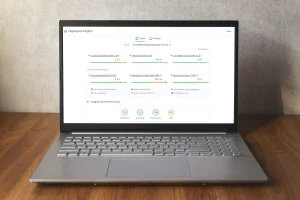Why Image Compression Matters for Website Speed
On a typical site, images are the heaviest assets, often contributing the majority of the page weight. According to the HTTP Archive, the median desktop page transfers roughly 1–1.3 MB of images, and this number is higher for media-rich sites. Reducing image payload pays immediate dividends.
Speed isn’t just a developer metric—it impacts business outcomes. Studies have correlated a 1-second delay with decreased conversions, fewer page views, and lower customer satisfaction. That’s why image compression is a high-leverage tactic for improving website speed, user experience, and SEO.
How Image Compression Works: The Essentials
At its core, image compression reduces file size by removing or reorganizing data that doesn’t meaningfully change what users see. There are two primary approaches:
- Lossless image compression: Shrinks file size without changing pixels. Ideal for UI icons, logos, line art, and images that need pixel-perfect fidelity.
- Lossy image compression: Discards imperceptible details to dramatically reduce bytes. Best for photographs, hero images, and background visuals.
Choosing the right approach and format is key to balancing quality, speed, and accessibility.
Choosing Formats: WebP, AVIF, and When JPEG/PNG Still Win
Modern formats are designed for high compression ratios with excellent quality. Getting your formats right is often the single biggest optimization.
- WebP: Broad browser support and smaller sizes than JPEG/PNG in most cases. Great default for photos and graphics.
- AVIF: Even better compression than WebP at similar or better quality, especially for high-resolution photos. Slightly heavier to encode; support is now strong across modern browsers.
- JPEG: Still solid for photographic content when you need maximum compatibility. Use progressive JPEGs and tune quality.
- PNG: Ideal for transparency and crisp edges. Use PNG for UI and line art when vector or WebP/AVIF aren’t appropriate.
- SVG: For logos, icons, and illustrations, vector SVGs often beat raster images in clarity and size—no compression needed beyond minification.
Modern responsive strategies can serve AVIF or WebP to capable browsers and fall back to JPEG/PNG when needed, preserving website speed for all users.
Best Practices: Image Compression Techniques That Move the Needle
Implement these practical tips to achieve big gains without sacrificing quality:
- Right-size images: Don’t ship a 3000px image into a 600px slot. Generate multiple sizes and use srcset/sizes for responsive delivery.
- Compress aggressively but intelligently: For lossy formats, start around quality 60–75 (WebP/JPEG) and test across devices. AVIF can often go lower with excellent results.
- Use lossless optimization: Strip metadata, optimize Huffman tables, and run PNG/JPEG optimizers. Even small savings add up.
- Adopt next-gen formats: Serve AVIF/WebP with fallback to maximize image compression benefits across browsers.
- Lazy-load below-the-fold images: Pair compression with loading=“lazy” to delay non-critical assets, improving LCP and FCP.
- Preload critical images: For hero images affecting LCP, preload the largest source to accelerate rendering.
- Use CDNs with image processing: Offload resizing, format negotiation, and caching to the edge for consistent website speed.
Lossless vs. Lossy Image Compression: When to Choose Which
Think about content type and business requirements:
- Brand assets (logos, UI icons): Favor lossless or SVG to protect brand fidelity.
- Product photos and lifestyle photography: Typically lossy with a tuned quality setting in AVIF or WebP. Validate on retina screens.
- Charts and screenshots: If text clarity is critical, test lossless (PNG/WebP lossless) or high-quality lossy settings.
A/B test compression levels on key templates to find the sweet spot where users don’t perceive quality loss but performance jumps.
Image Compression and Core Web Vitals
Optimized images improve multiple Core Web Vitals:
- LCP (Largest Contentful Paint): Heavily impacted by hero images. Compress, preload, and serve in next-gen formats to cut LCP.
- CLS (Cumulative Layout Shift): Always specify width/height or use aspect-ratio in CSS so images reserve space before loading.
- INP (Interaction to Next Paint): Lighter pages reduce main-thread contention and network overhead, improving responsiveness.
Google’s performance guidance consistently recommends optimized images to meet thresholds. See the official best practices and audits in tools like PageSpeed Insights and Lighthouse.
Real-World Example: E‑commerce Gains from Image Compression
A mid-market retailer reduced average product image weight by 62% by migrating JPEGs to AVIF with quality targeting per category. Page weight dropped by ~800 KB on product detail pages, cutting median LCP from 3.4s to 2.2s on 4G.
In the following six weeks, the team recorded a 9% lift in mobile conversion rate and a 13% decrease in bounce rate, correlating closely with improved website speed. While results vary by site, these outcomes align with established research linking faster pages to higher engagement and revenue.
Building an Automated Image Compression Workflow
Manual optimization doesn’t scale. Automate image compression from source to production:
- Ingest: Designers export high-resolution assets to a shared folder or DAM.
- Pipeline: A CI job or serverless function:
- Generates responsive sizes (e.g., 320–2560px widths).
- Outputs AVIF and WebP plus fallback JPEG/PNG.
- Applies tuned quality settings and strips metadata.
- Writes cache-friendly file names with content hashes.
- Delivery: A CDN handles caching, format negotiation (Accept header), and regional edge delivery.
- Monitoring: Lighthouse CI or WebPageTest in your pipeline prevents regressions by flagging oversize images.
Tools and Services for Effortless Image Compression
Choose tools that fit your stack and scale:
- CLI and build tools: Squoosh CLI, Sharp, imagemin, libvips for automated pipelines.
- CDN-based optimization: Cloudflare Images, Akamai Image & Video Manager, Fastly Image Optimization, Imgix, Cloudinary.
- CMS plugins: WordPress (ShortPixel, Imagify, EWWW), Shopify (built-in + apps), headless CMS hooks.
- Design-to-web handoff: Encourage exports with target dimensions; avoid shipping raw photography.
Whichever route you pick, enforce budgets. For instance, cap hero images at 150–250 KB (AVIF/WebP) where feasible and thumbnails under 20–30 KB.
HTML Patterns That Supercharge Image Compression Benefits
Use responsive markup so the browser downloads the best asset for each viewport:
<picture>
<source type="image/avif" srcset="hero-800.avif 800w, hero-1600.avif 1600w" sizes="(max-width: 800px) 100vw, 800px">
<source type="image/webp" srcset="hero-800.webp 800w, hero-1600.webp 1600w" sizes="(max-width: 800px) 100vw, 800px">
<img
src="hero-800.jpg"
srcset="hero-800.jpg 800w, hero-1600.jpg 1600w"
sizes="(max-width: 800px) 100vw, 800px"
width="800" height="450"
loading="lazy"
decoding="async"
alt="Product hero">
</picture>This pattern ensures you combine image compression with responsive sizing, next-gen formats, lazy-loading, and layout stability.
Common Pitfalls That Slow Down Website Speed
- Oversized originals: Uploading 6–12 MB photos directly from cameras or phones.
- Single-size exports: Serving the same image to all devices instead of using srcset.
- Ignoring transparency: Using PNG when JPEG/AVIF/WebP without alpha would be smaller.
- UI images as bitmaps: Shipping raster icons instead of SVG.
- No caching strategy: Frequent cache misses or query-string image URLs that defeat CDN caching.
Measuring Success: Prove the Impact of Image Compression
Before-and-after tests validate changes and guide iteration. Track:
- Core Web Vitals: LCP, CLS, INP via field data (CrUX, RUM) and lab tests (Lighthouse).
- Payload metrics: Total image bytes and number of requests.
- Speed Index and TTI: From WebPageTest, to understand overall experience.
- Business metrics: Conversion rate, bounce rate, and session depth.
Set performance budgets to prevent regressions and integrate checks into CI so new images meet your standards by default.
Quick-Start Checklist: Image Compression for Website Speed
- Convert heavy JPEG/PNG assets to AVIF or WebP with tuned quality.
- Generate responsive sizes and implement srcset/sizes or picture.
- Lazy-load non-critical images; preload the hero image.
- Strip metadata; apply lossless optimization where appropriate.
- Serve via a CDN with smart caching and format negotiation.
- Monitor Core Web Vitals and enforce performance budgets.
Further Reading and Trusted Guidance
For in-depth best practices and audits, explore Google’s performance guides on optimized images and loading strategies. They offer practical steps and diagnostics to ensure you’re shipping the smallest, fastest assets possible.
Read the official web.dev fast loading guide
Internal Linking Suggestions
- Core Web Vitals Guide: How to Improve LCP, CLS, and INP
- Lazy Loading Images and Video: A Practical Implementation Tutorial
- Choosing the Right CDN for Performance and Scalability
- Responsive Images: Mastering srcset, sizes, and picture
- Performance Budgets: Keep Your Site Fast as You Scale
Conclusion: Make Image Compression Your Competitive Edge
Ultimately, image compression is the easiest, most reliable lever for improving website speed and user experience. By adopting modern formats, automating your workflow, and enforcing performance budgets, you’ll deliver visually rich pages that load fast on any device or network. Start with your heaviest templates, run a quick audit, and ship incremental improvements—your users and KPIs will thank you.



